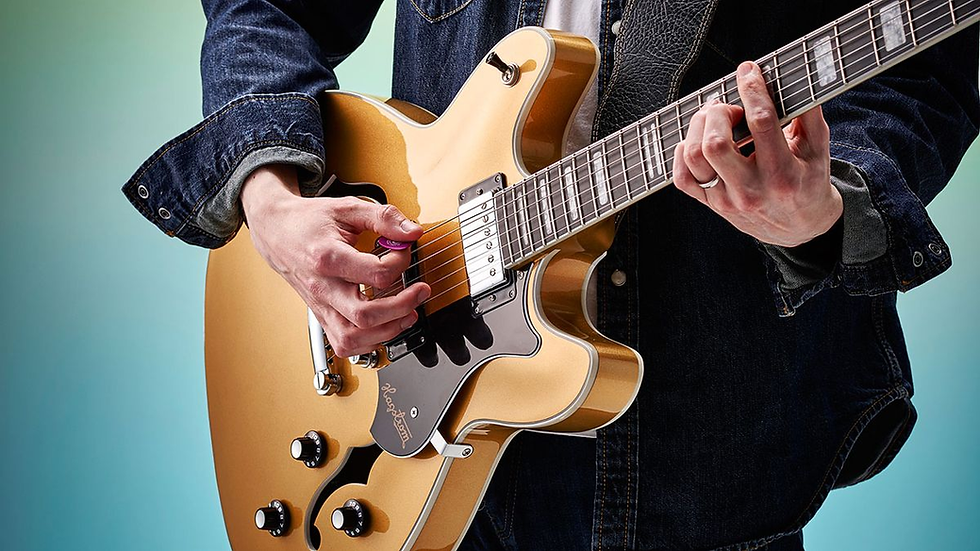How to Amplify an Acoustic Guitar
- The American Guitar Academy

- Jul 1
- 6 min read
Amplifying an acoustic guitar is a crucial step for musicians who want to ensure their sound is heard clearly in a variety of settings, from intimate coffee shops to large concert venues. While acoustic guitars are designed to project sound naturally, there are many situations where amplification becomes necessary to enhance volume, tone, and overall performance quality. This article will guide you through the process of amplifying an acoustic guitar, exploring the equipment, methods, and techniques needed to achieve the best-amplified sound.

Understanding Acoustic Guitars
Before diving into the methods of amplification, it's important to understand the basic structure of an acoustic guitar and how it produces sound. The body of an acoustic guitar, typically made from tonewoods like spruce, mahogany, or rosewood, consists of the top (soundboard), back, and sides. It serves as a resonating chamber that amplifies the vibrations from the strings. The strings vibrate when plucked or strummed, producing sound. The bridge, located on the body, anchors the strings and transmits their vibrations to the soundboard. The soundhole, typically round, is where the sound produced by the vibrating strings is projected out of the guitar's body. When a string is plucked, it vibrates and transfers its energy to the soundboard via the bridge. The soundboard amplifies these vibrations, which resonate within the guitar body and are projected out through the soundhole. This natural amplification process gives the acoustic guitar its distinctive tone and volume.
Why Amplify an Acoustic Guitar?
Amplifying an acoustic guitar offers several advantages. Amplification allows the guitar to be heard over other instruments in a band setting or in larger venues, increasing volume. With amplification, players can adjust the tone and EQ settings to suit different musical styles and environments, enhancing tone control. Amplified acoustic guitars can produce clearer and more defined recordings, improving recording quality. Additionally, amplified guitars can easily switch between different sounds and effects, enhancing live performances.
There are several situations where amplification is necessary. Playing in a large venue or with a full band requires amplification to ensure the guitar is audible. Professional recordings often require a clear and controlled sound, which can be achieved through amplification. Amplification is essential for maintaining sound quality in open-air environments during outdoor events. Practicing with amplification can help musicians get accustomed to their live performance setup.
Methods of Amplifying an Acoustic Guitar
One of the simplest and most effective ways to amplify an acoustic guitar is by using a microphone. This method captures the natural sound of the guitar and can produce high-quality results. A microphone captures the true acoustic qualities of the guitar, offering natural sound reproduction. Microphones can be used in various setups, both live and in studio environments, providing flexibility. Furthermore, no permanent changes are made to the guitar, minimizing modification. However, microphones are prone to feedback, especially in loud environments, and the guitar must remain relatively stationary in front of the microphone, limiting mobility.
Pickups are devices that convert the guitar's vibrations into electrical signals, which can then be amplified. There are several types of pickups. Soundhole pickups are mounted in the guitar's soundhole and are easy to install and remove. They offer simple installation, good sound quality, and portability but can affect the guitar's natural resonance and may require external preamps. Under-saddle pickups are installed beneath the guitar's saddle, providing a direct method of capturing string vibrations. They offer excellent feedback resistance and good sound quality but require professional installation and can alter the guitar's acoustic properties. Contact pickups are attached to the guitar's soundboard, capturing the vibrations directly from the surface. They are easy to install and preserve the natural acoustic sound but can be prone to feedback and may require precise placement for optimal sound.
An acoustic guitar amplifier is specifically designed to amplify the sound of an acoustic guitar without altering its natural tone. Amplifiers provide various controls for shaping the sound, including EQ, reverb, and effects, enhancing sound control. Many amplifiers have built-in feedback suppression features, offering built-in feedback control. They can be used in different performance settings, from small gigs to large venues, providing versatility. However, quality amplifiers can be expensive, and they can be bulky and heavy, making them less portable. Many acoustic amps feature both microphone and pickup inputs which can be blended.
Choosing the Right Equipment
Selecting the right equipment for amplifying your acoustic guitar depends on several factors. First, determine how much you are willing to spend. Consider the tonal characteristics you want to achieve, as sound quality is crucial. Some pickups require professional installation, while others can be easily installed by the player, so consider the ease of installation. Portability is another important factor; consider the weight and size of the equipment if you plan to travel with it. Ensure the equipment has features to minimize feedback, especially for live performances.
For budget options, consider the Shure SM57 microphone, which is affordable and versatile. The Fishman Neo-D Single Coil pickup is easy to install and cost-effective. The Fender Acoustasonic 15 amplifier is compact and budget-friendly. For mid-range options, the Audio-Technica AT2020 microphone offers a great balance of quality and price. The LR Baggs Element Active System pickup provides high-quality sound with easy installation. The Roland AC-60 amplifier offers excellent sound and features for the price. For high-end options, the Neumann KM184 microphone provides studio-quality sound reproduction. The Fishman Matrix Infinity pickup offers top-notch sound and performance. The AER Compact 60 amplifier is a professional-grade amplifier with outstanding clarity.
Setting Up the Amplification Equipment
Once you've chosen the right equipment, setting it up correctly is crucial for achieving the best sound. For setting up a microphone, place the microphone about 6-12 inches from the guitar's soundhole, angled slightly towards the 12th fret to capture a balanced sound. Ensure the microphone stand is stable and at the right height. Use an XLR cable to connect the microphone to your mixer or amplifier. Adjust the input levels to prevent distortion and ensure a clear sound.
For setting up a pickup, follow the manufacturer's instructions for installing the pickup in your guitar. This may involve placing it in the soundhole, under the saddle, or attaching it to the soundboard. Some pickups require an external preamp to boost the signal. Use a guitar cable to connect the pickup to your amplifier and fine-tune the amplifier's settings to match your desired sound.
For setting up an acoustic guitar amplifier, place the amplifier in a location where it can project sound effectively and minimize feedback. Use a high-quality instrument cable to connect your guitar to the amplifier. Adjust the bass, mid, and treble controls to shape your tone. Play your guitar and make any necessary adjustments to the volume, tone, and effects.
When setting up your equipment, consider safety precautions. Keep the amplifier at a reasonable distance from the guitar to prevent feedback. Ensure all cables are properly connected and secured to avoid tripping hazards. Start with low volume levels and gradually increase to prevent damage to your hearing and equipment.
Optimizing the Sound
Achieving the best-amplified sound requires fine-tuning and adjustments. Use the EQ controls to adjust the bass, mid, and treble settings to suit the acoustics of the room and the style of music you are playing. Experiment with microphone placement, as small changes in position can significantly affect the sound. Utilize effects sparingly; reverb and other effects can enhance your sound, but use them in moderation to avoid overwhelming the natural tone of your guitar.
Amplifying Acoustic Instruments is Tricky
Amplifying an acoustic guitar can greatly enhance your performance, whether you are playing live, recording in a studio, or practicing at home. Understanding the basic structure of your guitar and how it produces sound is the first step. Choosing the right equipment, whether it's a microphone, pickup, or amplifier, is crucial for achieving the best sound quality. Setting up your equipment correctly and optimizing your sound through fine-tuning and adjustments will help you achieve the best-amplified sound possible. By experimenting with different amplification methods and equipment, you can find the setup that works best for you and develop your unique sound.
Experiment with as many different configurations as you can and optimize your setup to suit your needs. There is no right answer and every case requires special considerations. Good luck!



